Eugene de Blaas
Eugene de Blaas, also known as Eugene von Blaas or Eugenio Blaas (24 July 1843 – 10 February 1931), was an Italian painter in the school known as Academic Classicism.
Eugene de Blaas | |
|---|---|
 Self portrait | |
| Born | July 24, 1843 Albano, Italy |
| Died | February 10, 1931 (aged 87) |
| Other names | Eugene von Blaas Eugenio Blaas |
| Parent(s) |
|
Life and career
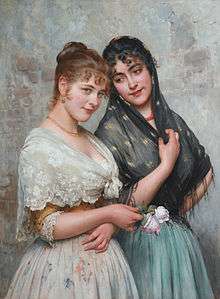
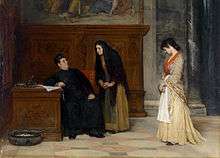
He was born at Albano, near Rome, to Austrian parents. His father Karl, also a painter, was his teacher. The family moved to Venice when Karl became Professor at the Academy of Venice. He often painted scenes in Venice, but also portraits and religious paintings.
Works
Among his works are La forma nuziale in sacrestia; La tombola in Campielo a Venezia; Una scena di burattini in un educanciatu; and La Ninetta. The art critic Luigi Chirtani, when the painting was displayed at the Mostra Nazionale di Venezia, described it as Beautiful, flattering, pretty, caressed, cleaned, polished, laundress in a painting by Mr. Blaas, the favorite portraitist of great Venetian aristocrats, dressed in gala satins, shining jewelry, hairstyles of the rich. [1]
His colorful and rather theatrical period images of Venetian society, e.g. On the Balcony (1877; Private Collection), were quite different compared to delicate pastels and etchings of the courtyards, balcony and canals of modern Venice.
Eugene de Blaas' paintings were exhibited at the Royal Academy, Fine Art Society, New Gallery and Arthur Tooth and Sons Gallery in London, and also at the Walker Art Gallery in Liverpool.[2]
Paintings
- The Sisters 1878 (Cloister-Scene)
- Conversions of the Rhætians by St. Valentine
- Cimabue and Giotto
- Scene from the Decameron
- Dogaressa Going to Church
- Venetian Balcony Scene
- God's Creatures
- Bridal Procession, in San Marco
- Venetian Masquerade
- A Journey to Murano (Vienna Museum)
- Die Wasserträgerin (1887)
- In the Water (1914)
Works
.jpg) The Watercarrier
The Watercarrier De Musette
De Musette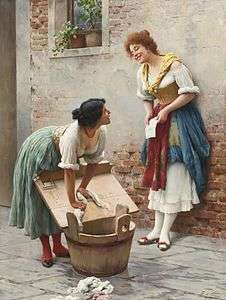 Sharing the News
Sharing the News The Spider and the Fly
The Spider and the Fly Arthur Graf Berchtold
Arthur Graf Berchtold.jpg) Daydreaming
Daydreaming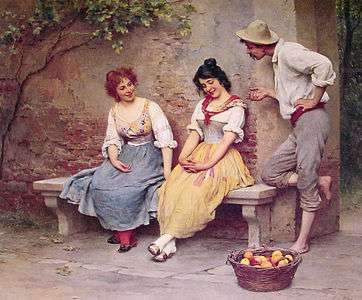 The Flirt
The Flirt.jpg) Curiosity
Curiosity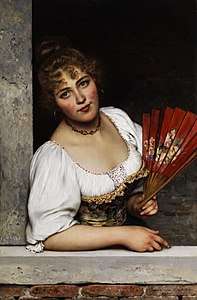 Der rote Fächer
Der rote Fächer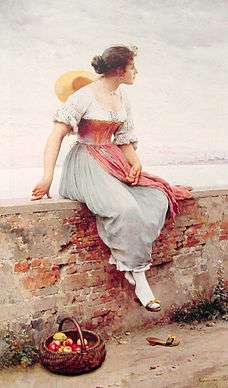 A Pensive Moment
A Pensive Moment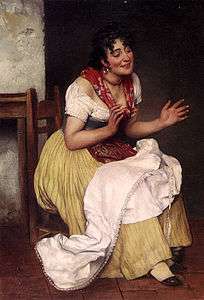 An interesting Story
An interesting Story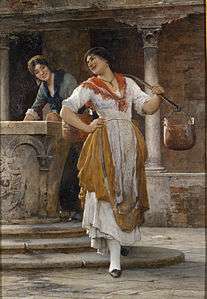 Die Wasserträgerin
Die Wasserträgerin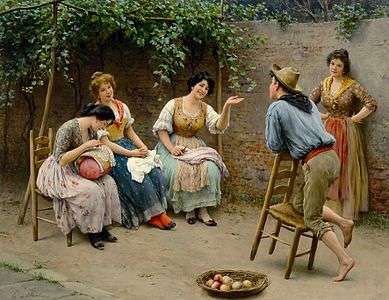 Chat
Chat.jpg)
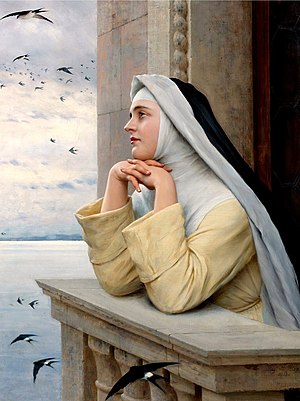
Cultural reference
- Salim Ghazi Saeedi has dedicated a song entitled "For Eugene, Distilling the Delicacy" to Eugene de Blaas in his 2011 album, Human Encounter.[3]
Notes
- Bellina, lusinghiera, linda, accarezzata, pulita, forbita, questa lavandaia rappresenta benissimo la pittura del signor Blaas, il ritrattista prediletto delle gran signoro veneziane, in veste di gala di raso, splendenti per gioielli, compite nelle ricche acconciature. in Dizionario degli Artisti Italiani Viventi: pittori, scultori, e Architetti., by Angelo de Gubernatis. Tipe dei Successori Le Monnier, 1889, page 61.
- "Biography of old oil painting master Eugene de Blaas". Favoritearts.info. Archived from the original on 2014-05-17. Retrieved 2013-11-07.
- "Human Encounter Album", Salim Ghazi Saeedi's Official Website, salimworld.com, Nov 2011
References
- Biography of old oil painting master Eugene de Blaas
- Wassibauer, Thomas (2005). Eugen von Blaas: 1843 - 1931 / Das Werk - Skizzen - Aquarelle - Gemälde. (Text in German and English)
External links

- Eugene de Blaas at artrenewal.org